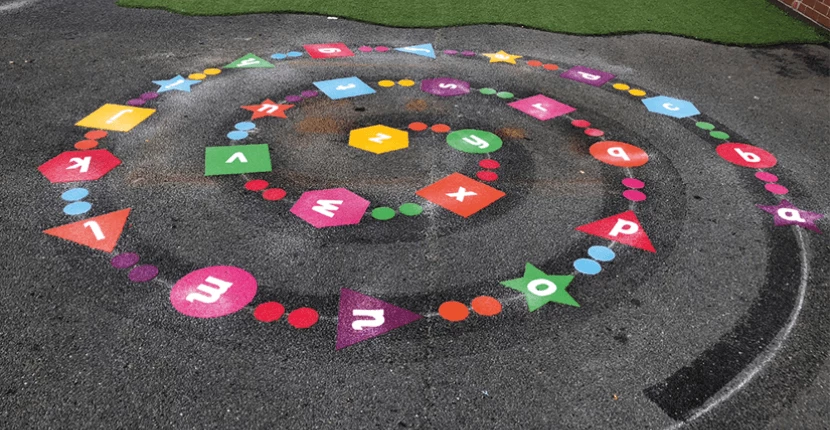
STEM Playground Markings in Bristol
Contact UsOur company specialises in creating dynamic STEM playground markings in Bristol are designed to transform outdoor spaces into interactive learning environments.
Our expertly crafted designs integrate Science, Technology, Engineering, and Mathematics into physical play, fostering cognitive and physical development for children aged 4–12.
We deliver durable solutions tailored to schools and communities with customisable options, weather-resistant materials, and compliance with all safety standards.
Our team ensures seamless installation, helping educators incorporate engaging, curriculum-aligned activities into daily routines.
Explore our range of designs, or contact us for a personalised quote to bring innovative STEM learning to your playground.
What are STEM Playground Markings?
STEM playground markings are innovative, interactive outdoor installations that merge play with learning in Science, Technology, Engineering, and Mathematics.
Crafted from durable thermoplastic, these markings transform standard playground surfaces in Bristol into dynamic, hands-on educational environments.
Through engaging designs and interactive challenges, children explore core STEM concepts, developing critical thinking, problem-solving, and teamwork skills while enjoying active outdoor play.
What Types of STEM Activities can be Enhanced with Playground Markings?
STEM playground markings provide a versatile foundation for enhancing various educational and physical activities.
These thermoplastic markings in Bristol turn outdoor spaces into dynamic environments where children can explore key STEM concepts through interactive play.
Numeracy Games: Engage in counting, number sequencing, addition, subtraction, and multiplication exercises using number grids or hopscotch designs.
Geometry Exploration: Identify shapes, angles, and symmetry through markings featuring polygons, circles, and tessellations.
Coordinate Mapping: Teach graphing and spatial awareness with Cartesian grids and plotting activities.
Time-Telling Skills: Use clock-face markings to learn to read analogue time and calculate elapsed time.
Measurement Challenges: Conduct hands-on activities involving distance, perimeter, area, and scaling.
Coding Simulations: Create simple coding paths or sequences, fostering algorithmic thinking and logic.
Physics Experiments: Explore concepts like force, motion, and balance with markings that support games and challenges.
Collaborative Problem-Solving: Facilitate teamwork through puzzles, pattern-matching, and other STEM-based group tasks.
Scientific Inquiry: Markings for observing natural patterns, such as sun shadows, encourage outdoor science experiments.
These activities make STEM subjects accessible, engaging, and memorable for children of all ages.
How much do STEM Playground Markings Cost?
The average cost of STEM playground markings is £600 - £3,000.
The price of thermoplastic STEM playground markings in Bristol varies depending on factors like material choice, design complexity, and surface area.
What are the Benefits of STEM Playground Markings?
STEM playground markings offer multiple benefits for schools and communities in Bristol by enhancing education, promoting inclusivity, and fostering development.
These benefits make playgrounds more engaging and purposeful, supporting academic and social growth.
Enhanced Learning Opportunities: Facilitate hands-on exploration of STEM concepts like numeracy, geometry, and coding through interactive outdoor play.
Improved Physical Activity: Encourage movement-based learning, promoting health and fitness alongside cognitive development.
Alignment with Curricula: Support teaching goals by integrating STEM-based lessons into everyday activities to reinforce classroom instruction.
Inclusivity and Accessibility: Offer activities suitable for diverse age groups and abilities, ensuring broad participation and engagement.
Community Engagement: Create inviting spaces that bring children, parents, and educators together, fostering a sense of community.
Cost-Effective Education Tools: Provide a durable, low-maintenance resource for schools to enhance STEM learning without ongoing expenses.
Skill Development: Promote teamwork, problem-solving, and critical thinking through structured and unstructured play activities.
Aesthetic Improvement: Enhance the visual appeal of playgrounds with vibrant, educational designs that serve functional purposes.
Environmental Awareness: Introduce concepts like measuring shadows or observing patterns in nature, connecting children with outdoor science learning.
By integrating learning and play, STEM playground markings help create well-rounded, engaging environments for children while supporting community values and educational goals.
How do STEM Playground Markings Support Learning?
STEM playground markings integrate educational content into physical activities, making learning an engaging experience.
Thermoplastic markings in Bristol encourage the exploration of concepts such as patterns, geometry, and basic calculations in a hands-on manner. Children can use the markings for structured lessons or independent discovery, fostering creativity and critical thinking.
Combining movement with intellectual challenges, these markings improve memory retention and help children understand abstract STEM ideas through real-world interaction.
Can STEM Playground Markings be Incorporated into Existing Playgrounds?
STEM playground markings can easily be added to existing playgrounds without major disruptions. The process begins with a site assessment to determine the best placement and compatibility with the current surface.
Thermoplastic markings can be applied directly to asphalt, concrete, or tarmac, while painted options may be suitable for other surfaces.
This adaptability makes it possible to upgrade playgrounds without requiring extensive renovations.
Are Grants or Funding Available for Installing STEM Playground Markings?
Grants and funding for STEM playground markings may be available through educational grants, local government initiatives, or community fundraising programmes.
Organisations like STEM charities and educational trusts often offer financial support for projects that enhance learning environments.
Schools and communities can research local and national funding opportunities to help cover the costs of design, materials, and installation.
Other Services We Offer
We cover Bristol
